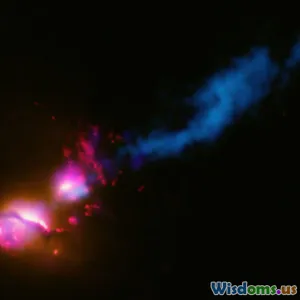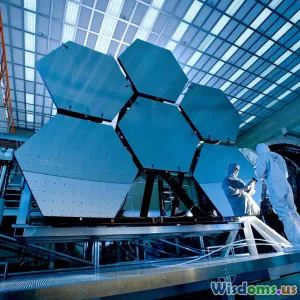
Secrets of Cosmic Dawn Captured by New Infrared Telescopes
9 min read Revealing cosmic dawn’s secrets via advanced infrared telescopes transforming our understanding of the universe’s birth and early evolution. (0 Reviews)
Secrets of Cosmic Dawn Captured by New Infrared Telescopes
The universe has always guarded its beginnings behind a cosmic veil—a time known as the Cosmic Dawn, when the first stars and galaxies ignited after the Big Bang. For centuries, this mysterious epoch eluded direct observation, limited by technological capabilities and the universe’s expanding nature. However, with the advent of cutting-edge infrared telescopes, astronomers now stand at the threshold of unraveling cosmic dawn's secrets, transforming our understanding of how the cosmos evolved.
Unveiling Cosmic Dawn: An Overview
Cosmic Dawn refers to the era roughly 100 million to 1 billion years after the Big Bang, when the first luminous objects emerged from the dark universe. Prior to this epoch, the cosmos was filled with neutral hydrogen and was an opaque, dark haven known as the cosmic dark ages.
This period is crucial because it marks the transition from simplicity to complexity—the foundation for everything from galaxies to eventually, life itself. But why has it been so challenging to observe this era?
The Challenge of Observing Cosmic Dawn
The cosmic dawn is shrouded in distance and time: signals from this time are faint, stretched, and redshifted into the infrared spectrum due to the expansion of the universe. Traditional optical telescopes can't detect these signals since their wavelengths have been elongated far beyond visible light.
Infrared astronomy is the key, but our planet’s atmosphere absorbs much of this radiation, making ground-based observations extremely challenging. Space-based infrared telescopes overcome this hurdle, peering deeper and more clearly into the universe’s primordial stages.
The New Era of Infrared Telescopes
James Webb Space Telescope (JWST): The Trailblazer
Launched in December 2021, the JWST represents a paradigm shift. Equipped with a 6.5-meter primary mirror and state-of-the-art instruments designed to observe in the near- and mid-infrared ranges (0.6 to 28.5 microns), JWST can detect light from objects over 13 billion years old.
Dr. Amber Roberts, an astronomer with the JWST team, emphasizes, “JWST gives us an unprecedented view of the earliest galaxies, pushing the boundaries beyond what Hubble could offer.” Early results showcase previously unseen galaxies, some shining just 300 million years after the Big Bang.
The Atacama Large Millimeter/submillimeter Array (ALMA)
While primarily a radio telescope, ALMA’s submillimeter band overlaps with infrared wavelengths relevant to cosmic dawn studies. ALMA’s high resolution and sensitivity enable precise mapping of cold gas and dust in early galaxies, crucial components in star formation.
ALMA’s combined observations with infrared space telescopes paint a comprehensive picture—showing how the first stars ignited and their environments evolved.
What Secrets Have Infrared Telescopes Revealed?
Discovery of Primitive Galaxies
Infrared telescopes have detected galaxies that are not only ancient but surprisingly massive and luminous. For example, JWST identified galaxies like GN-z11, now observed with more detail, revealing that massive galaxy formation occurred earlier than canonical models predicted.
These findings challenge existing cosmological theories about the pace and mechanisms of structure formation, suggesting that the universe’s environment was more conducive to rapid growth.
Insights into Star Formation and Metallicities
By analyzing the spectra of early galaxies, infrared instruments detect the signature of elements like carbon and oxygen. Surprisingly, some stars formed with higher metallicities than expected, hinting at rapid cycles of star death and rebirth even in these early epochs.
This alters our understanding of nucleosynthesis—the cosmic process responsible for forging elements, as even the universe’s first stars (‘Population III stars’) may have had complex lives impacting subsequent generations.
Understanding Cosmic Reionization
Cosmic reionization refers to the universe’s transition from neutral to ionized gas, enabling light to travel freely. Infrared observations help us trace this reionization timeline by observing Lyman-alpha emissions and ultraviolet light from first galaxies.
Recent JWST data refine the timeline, indicating the process might have occurred over a more extended period or in a patchy, non-uniform manner. Determining the sources responsible—prime suspects being hot, massive stars and quasars—is central to unraveling early cosmic phenomena.
The Role of Early Black Holes
New evidence from infrared spectra implies that primordial black holes, possibly formed from initial star collapses, existed and influenced galaxy formation via feedback processes. These supermassive black holes could have shaped galaxy morphology, star formation rates, and interstellar media.
Detecting these black holes at such high redshift provides an extraordinary glimpse into the universe’s earliest energetic events.
Real-World Impact: Advancing Technology and Collaborative Science
Technological Innovations
Infrared telescopes have catalyzed advancements in detector technologies, cooling systems, and optics. For instance, JWST’s primary mirror segments are coated with gold for maximum infrared reflectivity.
These technological feats enable ultra-sensitive measurements in extremely low-temperature environments, often nearing just a few degrees above absolute zero. The fallout benefits other fields, from medical imaging to environmental monitoring.
Collaborative Global Efforts
Studying cosmic dawn is inherently interdisciplinary and international. Observatories like JWST, ALMA, and future projects such as the Nancy Grace Roman Space Telescope and the European Extremely Large Telescope (ELT) combine data sets to provide multi-wavelength, high-fidelity insights.
This synergy exemplifies how collective investment in science propels human knowledge dramatically forward.
What Lies Ahead: Next Steps in Cosmic Dawn Exploration
Upcoming Missions and Ground-Based Observatories
Projects like the ELT, set to be operational by the late 2020s, will have mirrors over 39 meters wide, offering even greater resolution in infrared and optical wavelengths.
Additionally, ESA’s Euclid mission aims to map the large-scale structure of the universe, complementing infrared observations and deepening our knowledge of dark matter and energy.
The Quest for Population III Stars
While indirect evidence suggests the existence of Population III stars—metal-free stars formed from pristine hydrogen and helium—direct detection remains elusive. New infrared capabilities enhance the prospects to find these ancient stellar fossils, key to understanding the primordial universe’s chemistry.
Public Engagement and Citizen Science
As data from these telescopes become publicly available, citizen science initiatives increasingly engage global audiences in classifying galaxies and phenomena.
Projects like Galaxy Zoo have paved the way in democratizing knowledge-building, fostering public enthusiasm for cosmic discovery.
Conclusion
Infrared telescopes are revolutionizing our peek into the cosmic dawn, turning theoretical concepts into observable realities. By capturing faint light from more than 13 billion years ago, scientists are rewriting cosmic history—uncovering the processes that forged the first galaxies, stars, and black holes.
These discoveries not only expand our astronomical knowledge but ignite wonder about our cosmic origins, inviting humanity to gaze back through time itself. As technology jumps forward and global collaboration thrives, the secrets of cosmic dawn become ever less secret, fueling an inspiring pursuit to comprehend the universe’s majestic beginning.
Stay curious, for the skies still hold many mysteries waiting to be revealed.
Rate the Post
User Reviews
Other posts in Telescopes & Observatories
Popular Posts














